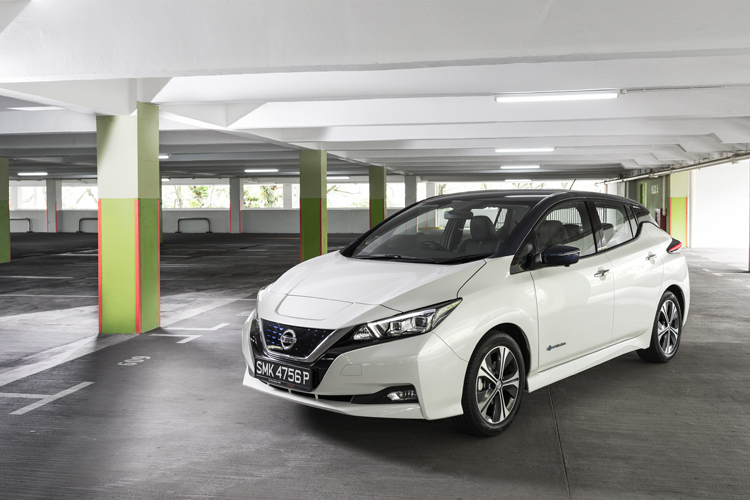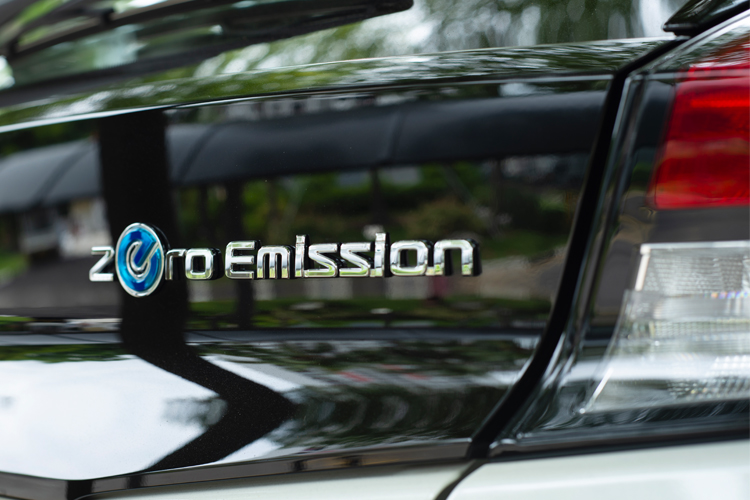
Torque writer Wong Kai Yi is impressed with the Nissan Leaf’s snappy performance.
Every time I drive the Nissan Leaf, I kid you not, I run straight into a massive traffic jam.
It’s not your garden-variety jam but a bumper-to-bumper tailback.
It was a sign, then, for me to try out the e-Pedal that Nissan advertises as a standout feature on the Leaf.

The e-Pedal’s premise is simple but highly effective: You can start, accelerate, decelerate and brake simply by depressing or lifting off the accelerator.
It’s very intuitive once you get the hang of it.
With e-Pedal mode engaged, you depress the Leaf’s the accelerator pedal to move off and when you want to stop, gently ease off.
The motor, through regenerative braking, slows you to a halt.

A good many electric cars also use strong regenerative braking to slow you down.
But Nissan is the only automaker which has refined it into something that you can use daily.
The system even automatically applies the brakes for you (and illuminates the stop lamp) when you’re stationary, so you can rest your hard-working right leg.
During my time with the Leaf, I challenged myself to only drive with the e-Pedal – and I succeeded.
It was definitely easier to drive with it and soon, I got quite used to modulating it without much difficulty.
With some practice, it’s entirely possible to drive the Leaf solely with the e-Pedal and help save some battery power in the process.
Ironically, my foot began aching after a while as I was constantly easing on and off in peak hour traffic.

Leaf’s instrument panel is intuitive and can be read at a glance.
But it sure beats having to do the throttle-brake-throttle dance that I smugly knew other drivers must be doing.
Also, unless you have plenty of practice driving backwards, parking manoeuvres are best done with e-Pedal off.
That’s because the strong regenerative braking can cause the car to jerk while you try to finesse it into a parking lot.
Which brings us onto the topic of the Leaf’s brakes.
When you depress the brake, the pedal feel could do with more bite.
There’s linearity to the braking feel, but no “hard stop” after some travel.
The Leaf brake feel is in no way terrible, but it just doesn’t have as meaty a bite as I would like.

This stubby knob-like component is actually the gearshift lever, whose layout takes some getting used to.
Aside from that, the Leaf is smooth on the road and like every other electric car, dead easy to drive.
And the Leaf also knows how to party.
With e-Pedal off, the Leaf leaps snappily away from the lights, putting some two-doors to shame with its 148hp and 320Nm of instant torque.
Round a corner with a touch of speed and the Leaf keeps body roll impressively in check, cornering with no histrionics and minimal fuss despite being shod with skinny eco-oriented Dunlop Enasaves.
But the Leaf’s steering, though largely accurate, is too light and doesn’t transmit much textural feel of the road surface.

Leaf’s electric motor delivers 148hp and 320Nm at 0rpm, or in an instant.
Some road noise and tyre roar is audible but overall, the Leaf is relatively quiet inside and the seats are very ergonomic and comfortable to sit on.
With innovative technology and a fuss-free driving experience, it’s not difficult to see why the Leaf has won plenty of international fame.
But starting at $160,300 with COE as of May 28, the Leaf in Singapore is within spitting distance of ye olde petrol cars like the Audi Q2, BMW 2 Series Gran Tourer, Mazda CX-5, Toyota Harrier, even the Hyundai i30 N.
And in EV land, the Leaf faces competition from the Hyundai Kona EV, the incoming Kia Niro EV and Renault Zoe.
The local version also doesn’t get Nissan’s clever ProPilot system, the company’s name for a suite of advanced driver-assistance technologies like steering control and adaptive cruise control.

But the Leaf has got its own merits.
It stands out with its innovative e-Pedal and huge 435-litre boot, making it more practical than most other EVs in its price range.
Add an effortless driving experience to that and it’s clear why you shouldn’t leave the Leaf out of your EV shopping list.
Nissan Leaf review: Practical electric hatch
Nissan Leaf review: Electrifying engineering
NISSAN LEAF
DRIVETRAIN
BATTERY 40kWh lithium-ion
MOTOR Single front-mounted synchronous electric
MAX POWER 148hp at 3283-9795rpm
MAX TORQUE 320Nm at 0-3283rpm
POWER TO WEIGHT 72.4kW per tonne
GEARBOX Single-speed constant ratio
DRIVEN WHEELS Front
PERFORMANCE
0-100KM/H 7.9 seconds
TOP SPEED 140km/h
CONSUMPTION Estimated 5.8km/kWh (combined)
RANGE 311km
SUSPENSION
FRONT MacPherson struts, coil springs
REAR Torsion beam, coil springs
BRAKES
FRONT / REAR Ventilated discs / Discs
TYRES
TYPE Dunlop Enasave EC300
SIZE 215/50 R17
SAFETY
AIRBAGS 6
TRACTION AIDS ABS, VSC
MEASUREMENTS
LENGTH 4480mm
WIDTH 1790mm
HEIGHT 1540mm
WHEELBASE 2690mm
KERB WEIGHT 1490kg
TURNING CIRCLE 11m
BUYING IT
PRICE $160,300 with COE
WARRANTY 5 years/unlimited km (vehicle); 8 years/160,000km (battery)
+ Easy driving with the e-Pedal, spacious boot, sleek styling
– Pricey, comparatively smaller range, cheap interior
















